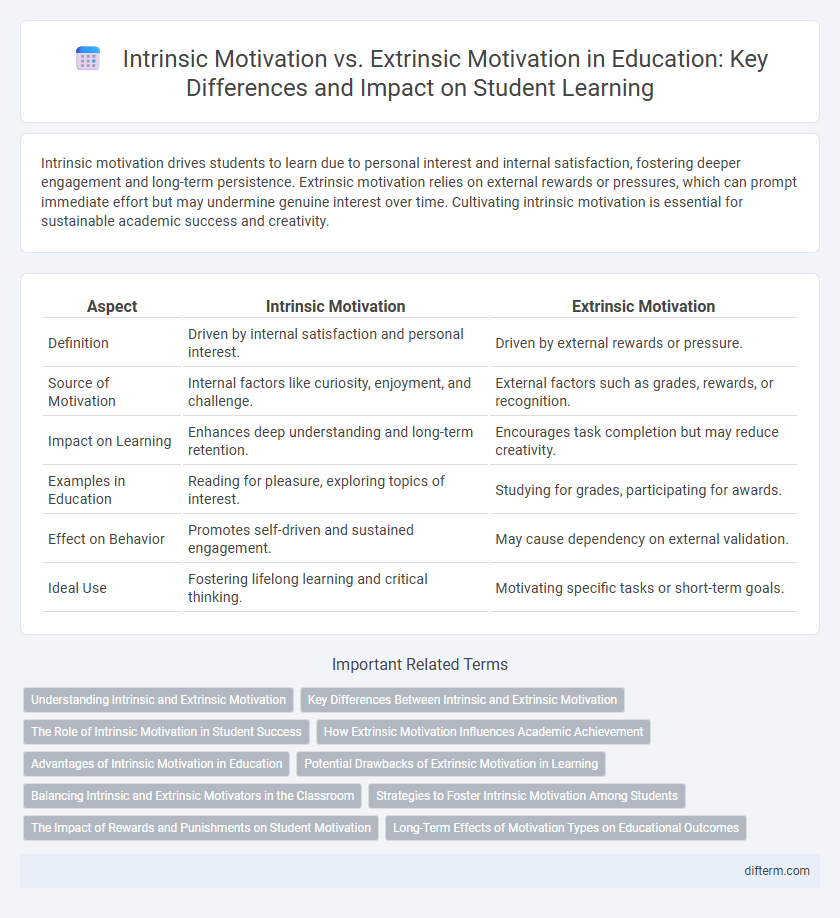Intrinsic motivation drives students to learn due to personal interest and internal satisfaction, fostering deeper engagement and long-term persistence. Extrinsic motivation relies on external rewards or pressures, which can prompt immediate effort but may undermine genuine interest over time. Cultivating intrinsic motivation is essential for sustainable academic success and creativity.
Table of Comparison
| Aspect | Intrinsic Motivation | Extrinsic Motivation |
|---|---|---|
| Definition | Driven by internal satisfaction and personal interest. | Driven by external rewards or pressure. |
| Source of Motivation | Internal factors like curiosity, enjoyment, and challenge. | External factors such as grades, rewards, or recognition. |
| Impact on Learning | Enhances deep understanding and long-term retention. | Encourages task completion but may reduce creativity. |
| Examples in Education | Reading for pleasure, exploring topics of interest. | Studying for grades, participating for awards. |
| Effect on Behavior | Promotes self-driven and sustained engagement. | May cause dependency on external validation. |
| Ideal Use | Fostering lifelong learning and critical thinking. | Motivating specific tasks or short-term goals. |
Understanding Intrinsic and Extrinsic Motivation
Intrinsic motivation drives students to engage in learning due to genuine interest and personal satisfaction, enhancing creativity and deep comprehension. Extrinsic motivation relies on external rewards such as grades, praise, or recognition, often leading to short-term compliance rather than sustained engagement. Recognizing the balance between intrinsic and extrinsic motivation is crucial for educators to foster a supportive and effective learning environment.
Key Differences Between Intrinsic and Extrinsic Motivation
Intrinsic motivation originates from an individual's internal desire to learn or achieve, driven by personal satisfaction and interest, whereas extrinsic motivation relies on external rewards such as grades, praise, or monetary incentives. Intrinsic motivation fosters deeper engagement and long-term commitment to educational tasks, enhancing creativity and problem-solving skills. In contrast, extrinsic motivation can produce immediate compliance but may undermine intrinsic interest if overused, potentially leading to reduced motivation once external rewards are removed.
The Role of Intrinsic Motivation in Student Success
Intrinsic motivation plays a crucial role in student success by fostering deep engagement, creativity, and sustained learning. Students driven by internal factors such as curiosity, personal interest, and the desire for mastery demonstrate higher academic achievement and resilience. Research shows that intrinsic motivation enhances critical thinking skills and long-term retention compared to extrinsic rewards like grades or praise.
How Extrinsic Motivation Influences Academic Achievement
Extrinsic motivation, driven by external rewards such as grades, praise, or scholarships, significantly impacts academic achievement by encouraging students to complete tasks and meet performance standards. Research indicates that extrinsic motivators can enhance short-term engagement and improve test scores but may not sustain long-term learning or foster a deep understanding of material. Balanced integration of extrinsic rewards with intrinsic goals creates an optimal environment for consistent academic success and personal growth.
Advantages of Intrinsic Motivation in Education
Intrinsic motivation in education fosters deeper engagement and long-term retention by encouraging students to pursue learning for personal satisfaction and curiosity. It enhances creativity, critical thinking, and self-regulation, leading to improved academic performance and lifelong learning habits. Unlike extrinsic rewards, intrinsic motivation builds internal commitment and resilience, reducing dependence on external validation.
Potential Drawbacks of Extrinsic Motivation in Learning
Extrinsic motivation in learning, such as rewards or grades, can undermine students' intrinsic interest by shifting focus from mastery to performance. Overreliance on external incentives may reduce creativity, critical thinking, and long-term engagement with the subject matter. Studies reveal that extrinsic rewards often lead to decreased motivation once the rewards are removed, limiting sustained academic growth.
Balancing Intrinsic and Extrinsic Motivators in the Classroom
Balancing intrinsic and extrinsic motivators in the classroom enhances student engagement and fosters deeper learning by combining personal interest with external rewards. Research indicates that intrinsic motivation drives long-term academic success, while extrinsic incentives, such as grades and praise, can effectively initiate engagement. Educators should strategically integrate both approaches, promoting autonomy and competence alongside clear performance goals to optimize motivation and achievement.
Strategies to Foster Intrinsic Motivation Among Students
Promoting intrinsic motivation in students involves providing autonomy, offering meaningful and relevant learning experiences, and encouraging mastery through challenges tailored to individual skill levels. Incorporating student choice and fostering a growth mindset enhances engagement by connecting learning to personal interests and goals. Supporting intrinsic motivation leads to deeper learning, increased persistence, and improved academic outcomes compared to reliance on extrinsic rewards.
The Impact of Rewards and Punishments on Student Motivation
Rewards and punishments significantly influence student motivation by shaping their engagement and perseverance. Intrinsic motivation, driven by internal satisfaction and interest, is often undermined when extrinsic rewards or punishments become the primary focus, leading to reduced long-term learning enthusiasm. Research indicates that while extrinsic incentives can boost short-term performance, fostering intrinsic motivation enhances deeper cognitive engagement and sustainable academic achievement.
Long-Term Effects of Motivation Types on Educational Outcomes
Intrinsic motivation fosters deeper engagement and sustained academic achievement by encouraging students to pursue learning for personal satisfaction and curiosity. Extrinsic motivation, driven by external rewards or pressures, can lead to short-term compliance but often diminishes long-term interest and persistence in educational tasks. Studies indicate that intrinsic motivation is a stronger predictor of enduring educational success, resulting in higher retention rates and greater self-regulated learning over time.
intrinsic motivation vs extrinsic motivation Infographic

 difterm.com
difterm.com